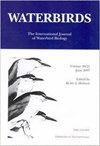Dietary Plasticity Mitigates Impacts to Reproduction for the Gull-Billed Tern Gelochelidon nilotica During Abnormally Warm Sea Surface Temperature Events in California, U.S.A.
IF 0.6
4区 生物学
Q3 ORNITHOLOGY
引用次数: 1
Abstract
Large scale oceanic processes can have profound consequences for marine and coastal food webs. Mortality and reproductive related impacts to seabirds have been documented for decades, and current research suggests that dietary flexibility may be a key component by which birds can mitigate environmental variation. Our motivation for this research was to better understand how a dietary generalist in the coastal environment responds to changes in prey food availability. The Gull-billed Tern Gelochelidon nilotica is a coastal nesting species that has an opportunistic generalist diet. We monitored both tern diet and density of a main prey resource to examine how responsive these terns are to annual variation in prey resources. Our results documented that the loss of a ubiquitous prey resource did not appear to influence tern annual reproductive success even though, in some years, Emerita analoga comprised greater than 70% of Gull-billed Tern diet. During breeding seasons with warmer than average sea surface temperatures, the Gull-billed Tern switched to a more terrestrial diet and focused aquatic foraging activities upon crustacean species that are more tolerant of warmer water temperatures. Dietary plasticity can be beneficial to mitigate variation in prey resource availability and impacts on reproductive success, and the ability to respond rapidly to changes in resources may play an important role in how coastal species can acclimate or adapt to annual changes in the prey base.美国加州异常温暖的海面温度事件中饮食可塑性减轻了对nilotica Gelochelidon鸥嘴鸥繁殖的影响
大规模的海洋过程可以对海洋和沿海食物网产生深远的影响。对海鸟的死亡率和生殖相关影响已经记录了几十年,目前的研究表明,饮食的灵活性可能是鸟类减轻环境变化的关键因素。我们进行这项研究的动机是为了更好地了解沿海环境中的饮食多面手如何应对猎物食物供应的变化。nilotica鸥嘴燕鸥是一种沿海筑巢的物种,它的饮食是机会主义的。我们监测了白燕鸥的饮食和主要猎物资源的密度,以研究这些白燕鸥对猎物资源年变化的反应。我们的研究结果表明,尽管在某些年份,类似的食物占鸥嘴燕鸥饮食的70%以上,但失去无处不在的猎物资源似乎并不影响鸥嘴燕鸥每年的繁殖成功率。在海面温度高于平均温度的繁殖季节,鸥嘴燕鸥转向更陆地的饮食,并将水生觅食活动集中在对温暖水温更耐受的甲壳类动物身上。饮食的可塑性有助于减轻猎物资源可得性的变化和对繁殖成功的影响,对资源变化的快速反应能力可能在沿海物种如何适应或适应猎物基础的年度变化中发挥重要作用。
本文章由计算机程序翻译,如有差异,请以英文原文为准。
求助全文
约1分钟内获得全文
求助全文
来源期刊

Waterbirds
生物-鸟类学
CiteScore
1.30
自引率
0.00%
发文量
0
审稿时长
6-12 weeks
期刊介绍:
Waterbirds is an international scientific journal of the Waterbird Society. The journal is published four times a year (March, June, September and December) and specializes in the biology, abundance, ecology, management and conservation of all waterbird species living in marine, estuarine and freshwater habitats. Waterbirds welcomes submission of scientific articles and notes containing the results of original studies worldwide, unsolicited critical commentary and reviews of appropriate topics.
 求助内容:
求助内容: 应助结果提醒方式:
应助结果提醒方式:


